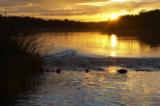 © Bruce McNitt/Panoramic Images (Virginia)
© Bruce McNitt/Panoramic Images (Virginia)

Nonpoint Source Pollution in Virginia
One particularly troublesome threat to biodiversity comes from nonpoint source pollution of surface waterways and groundwater. Nonpoint source pollution is basically pollution that doesn’t come from the end of a pipe. Some examples are petroleum products and salts washed off roads, nutrients from excess fertilizers spread on lawns, soil particles eroded from agricultural fields and acid precipitation derived from the combustion of fossil fuels.
DCR is the lead state agency for nonpoint source pollution and the Natural Heritage Program works closely with DCR’s soil and water conservation division to help address nonpoint source pollution threats.
Natural heritage data are used to help identify high priority waterways to help direct state and federal funds, which are used to reduce nonpoint source pollution. Natural Heritage Karst Program staff work with industries and localities to address problems associated with cave and groundwater pollution and are especially active in public education efforts. Natural heritage staff members provide information to landowners on best management practices and on government cost-share programs that can help reduce pollution, which results from agricultural and timber harvesting activities.



